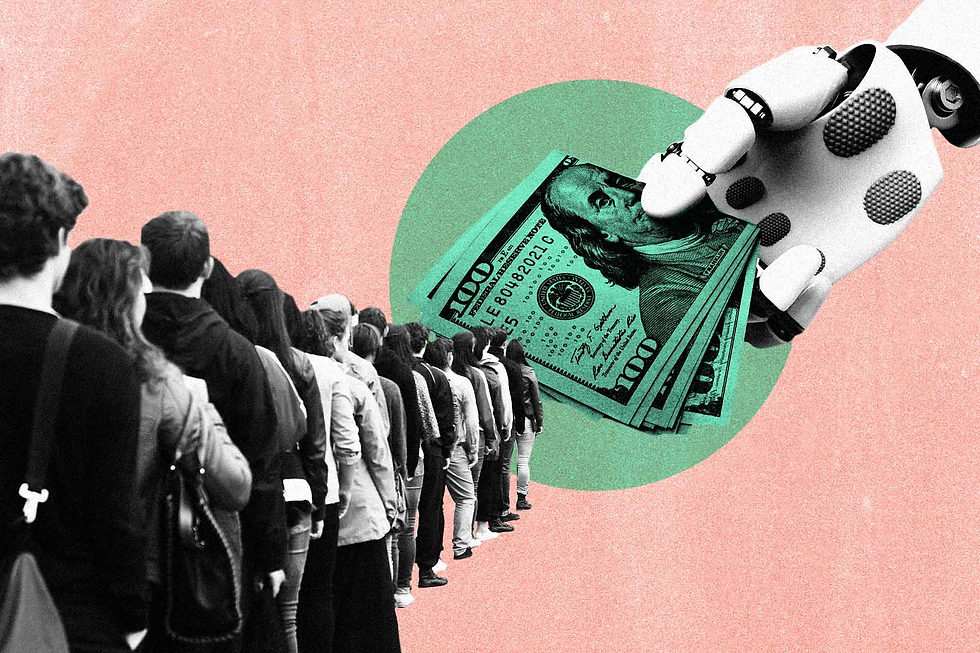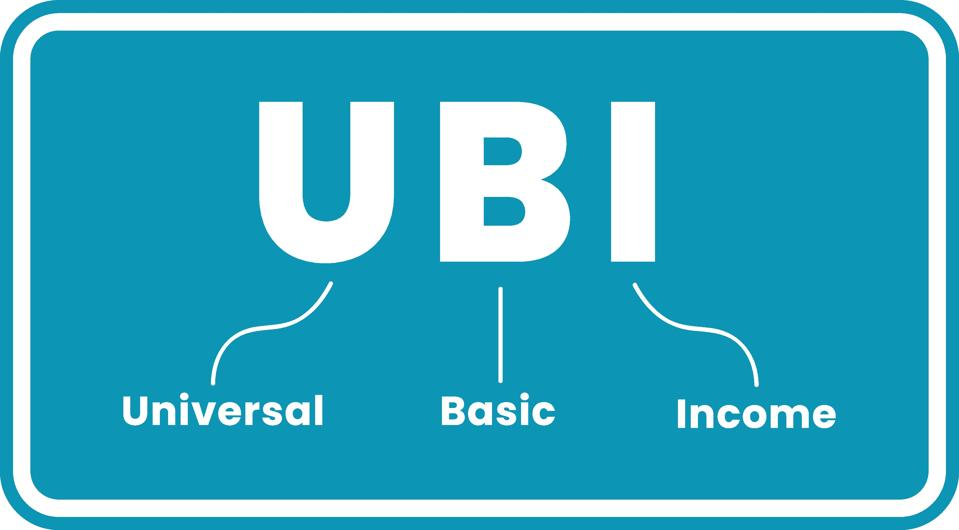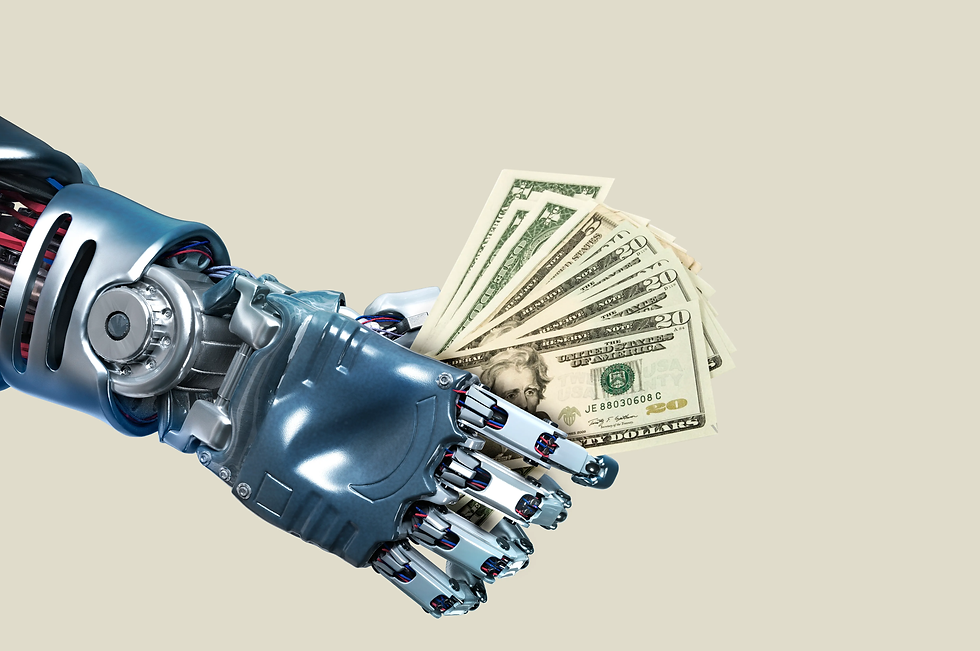AI-Funded Universal Basic Income: Could Automation Finally Unlock Financial Freedom for Everyone?
- Olivia Johnson

- Aug 15
- 11 min read

What is AI-Funded Universal Basic Income and Why It Matters
AI-Funded Universal Basic Income (AI-funded UBI) refers to a universal cash transfer provided to all individuals, financed in whole or in part by wealth generated through artificial intelligence. This new funding model draws on revenues from AI-driven automation, taxes levied on automated systems, platform levies on dominant AI service providers, or rents collected from data and computational resources essential to AI operations. Unlike traditional welfare programs, AI-funded UBI aims to redistribute the economic gains produced by AI technologies back to the broader population, ensuring that the benefits of automation are shared equitably.
The relevance of AI-funded UBI has grown sharply amidst accelerating AI automation and the rising risk of job displacement. With generative AI and machine learning rapidly transforming industries—ranging from manufacturing and logistics to services and creative sectors—many workers face structural unemployment or precarious labor conditions. Widening income inequality coupled with these labor market shifts has sparked intense policy and industry debates around how to create a social safety net for the AI era. Leading voices argue that AI-funded UBI could become an essential mechanism to stabilize economies and foster inclusive prosperity in a future where human labor is increasingly supplemented or replaced by intelligent machines.
This article evaluates the mechanisms that could finance AI-funded UBI, examines its economic feasibility, explores relevant policy frameworks, and surveys real-world case scenarios. Practical next steps for governments, industry, and civil society are also outlined to guide the transition toward an AI-enabled social contract. For those interested in how automation might reshape social welfare, understanding AI-funded UBI is critical to preparing for the coming changes. Insights from thought leaders such as Bernard Marr in Forbes highlight why many see this as an inevitable evolution in social policy, while Cornelia Walther's analysis frames it as a compelling business case for the AI era.
Background: The AI-UBI Debate and Historical Context

Universal Basic Income (UBI) is not a new idea. Over the past decades, various pilots and programs have tested unconditional cash transfers aimed at reducing poverty and stabilizing incomes. The Alaska Permanent Fund Dividend, distributing oil revenues annually to all residents since 1982, exemplifies resource-based universal payments. Finland’s recent experiment with UBI tested direct monthly payments to unemployed citizens to assess impacts on employment and well-being. Other pilots worldwide have explored different models of universality, conditionality, and payment frequency.
However, the rise of AI introduces new dynamics that renew interest in UBI as a policy response. Unlike prior automation waves focused on manufacturing or routine tasks, modern AI technologies generate unprecedented productivity gains while creating concentrated economic power in platform monopolies that control vast data and computational assets. These platforms accrue data and compute rents—economic returns derived not from labor but from ownership of digital resources essential for AI performance.
These shifts carry significant risks of structural unemployment, with some estimates suggesting that up to 30% of jobs could be displaced or fundamentally transformed by advanced AI within the next two decades. This potential scale of disruption challenges traditional labor market policies and social safety nets, making universal income support mechanisms more crucial.
Academic modeling frames the rationale for UBI in this context by linking technological displacement with income support thresholds needed to maintain social cohesion and economic stability. Research published on arXiv highlights theoretical points where automation-driven job losses outpace job creation, necessitating income redistribution through mechanisms like UBI. Policy foundations for such safety nets emphasize regulatory considerations needed to manage new revenue sources and ensure equitable distribution.
How AI Changes the UBI Rationale
The current wave of AI-driven automation differs fundamentally from past technological shifts in both scale and speed. Whereas earlier automation mostly replaced manual or repetitive tasks over decades, generative AI and machine learning increasingly automate complex cognitive tasks across sectors such as finance, legal services, healthcare diagnostics, and creative production. This accelerates task displacement even within jobs previously considered secure.
For example, studies estimate that up to 40% of tasks in administrative roles may be automated within five years, with entire jobs potentially eliminated in customer service or transportation sectors due to autonomous systems. This rapid transformation requires more robust income support mechanisms than traditional welfare programs can provide.
Lessons from Past UBI Pilots That Matter for AI-Funded Models
Past UBI pilots reveal important lessons for designing programs suited to an AI-funded model. Many pilots found that unconditional cash transfers do not significantly reduce work incentives; instead, they improve recipients’ well-being and provide financial stability that can spur entrepreneurship and retraining efforts. Fiscal cost signals from smaller-scale pilots suggest that universality simplifies administration but requires sustainable funding sources.
Key design aspects like whether payments are universal versus targeted, conditional versus unconditional, and payment timing (monthly versus quarterly) affect political acceptability and effectiveness. These insights inform considerations for implementing AI-funded UBI programs that balance inclusivity with fiscal responsibility.
How AI Could Actually Fund Universal Basic Income: Mechanisms and Models

Financing AI-funded Universal Basic Income requires innovative mechanisms that tap into the new wealth generated by artificial intelligence technologies. Several concrete approaches have been proposed:
Automation or Robot Taxes: Levies on companies deploying automated systems or robots that replace human labor.
Corporate AI Profit-Sharing: Mandated sharing of profits derived specifically from AI-driven products or services.
Data and Algorithmic Rents: Collection of rents on data assets or proprietary algorithms that power AI platforms.
Sovereign Compute Dividends: Charging fees or royalties on computational resources used by large AI entities.
Transaction or Platform Levies: Taxes on digital transactions facilitated by dominant AI-powered platforms.
Carbon-style Cap-and-Dividend for Compute: Setting caps on compute usage or energy consumption associated with AI training and redistributing proceeds as dividends.
These funding streams can be categorized into one-time wealth capture—such as capital gains from buyouts or initial public offerings—and ongoing revenue streams like periodic taxes or royalties.
A critical challenge lies in the technical feasibility of accurately tracking AI-driven value creation. Attributing profits to specific AI applications requires sophisticated accounting methods and robust infrastructure to monitor compute usage, data flows, and revenue sources.
Evaluations underscore the need for transparent reporting standards and audit capabilities to ensure reliable funding flows for sustainable UBI programs.
Automation Taxes, Data Rents, and Platform Levies — Pros and Cons
Each revenue source has unique advantages and drawbacks:
Mechanism | Pros | Cons |
|---|---|---|
Automation Taxes | Direct link to job displacement; visible | May discourage innovation; enforcement complexity |
Data Rents | Targets concentrated digital assets | Valuation challenges; privacy concerns |
Platform Levies | Captures large-scale digital transactions | Risk of tax base erosion; lobbying resistance |
Automation taxes are straightforward in principle but risk slowing technology adoption if set too high. Data rents exploit monopoly power over information but require precise valuation frameworks. Platform levies can generate significant revenues but may provoke avoidance strategies through transfer pricing or geographic shifts.
Policymakers benefit from comparing these options based on economic efficiency, ease of collection, evasion risk, and innovation incentives before selecting optimal mixes.
Technical Requirements to Measure AI Value Creation
Accurate measurement of AI value creation hinges on:
Value Attribution Metrics: Linking revenues directly to AI-driven processes versus human labor components.
Transaction Tracing: Using digital ledgers or blockchain systems to trace fund flows related to AI services.
Compute Usage Accounting: Monitoring actual compute resources consumed during AI training and inference phases.
Standardized reporting frameworks coupled with independent audits can enforce transparency on revenue sources earmarked for UBI funding. Digital ledger technologies offer promising tools to implement verifiable revenue streams while protecting privacy.
Economic Feasibility and Market Impact of AI-Funded UBI

Macroeconomic modeling provides insights into how much sustainable universal basic income can be supported by revenues derived from AI platforms under various scenarios:
Conservative Scenario: Modest taxation rates applied amid slow growth in AI profits.
Moderate Scenario: Balanced revenue shares with steady expansion of automation.
Optimistic Scenario: High profit capture combined with rapid scaling of AI services.
These models consider employment impacts such as reduced labor supply due to automation offset by consumption multipliers where cash transfers spur demand in local economies.
Potential macroeconomic effects include inflationary pressures if increased incomes outpace supply capacity, but positive fiscal crowding-in may occur if UBI enables higher productivity through retraining initiatives.
Modeling Example — How Much Could AI Revenue Support Per-Person UBI?
Consider a hypothetical Nation X with a population of 50 million people. Suppose dominant AI platforms generate $500 billion in annual profits attributed directly to automated services.
If policymakers decide to capture 20% of these profits through corporate levies or data rents for UBI funding:
Total funds available = $500 billion × 20% = $100 billion annually.
Per capita annual UBI = $100 billion ÷ 50 million = $2,000 per person.
Monthly payment equivalent = approximately $167 per person.
This amount could provide a meaningful baseline supplement to existing incomes but would require strong assumptions about profit attribution accuracy and political willingness to impose such levies.
Real-world numbers would vary widely depending on computation methods, tax enforcement efficacy, and economic growth trajectories.
Labor Market and Consumption Effects — Short and Long Term
Predictable cash transfers from an AI-funded UBI can boost consumer demand immediately by increasing disposable incomes across socioeconomic groups. In the short term, this can stabilize markets potentially disrupted by automation-related job losses.
Long-term effects include stronger incentives for retraining as individuals have financial buffers during employment transitions. Entrepreneurship may flourish due to reduced income uncertainty, while leisure choices expand as work becomes less financially imperative.
Studies suggest that such transfers do not significantly reduce labor force participation but do improve quality of life metrics.
Policy, Regulation and Governance Frameworks for AI-Funded UBI

Implementing an AI-funded Universal Basic Income demands a comprehensive legal and institutional framework:
Enacting revenue laws specifying tax bases on automation profits, data rents, or compute usage.
Establishing efficient distribution mechanisms ensuring timely payments.
Creating independent oversight bodies tasked with monitoring collections and expenditures.
Introducing robust anti-evasion rules including penalties for misreporting or avoidance.
International coordination is critical due to cross-border nature of many platform revenues. Without supranational cooperation, base erosion and profit shifting could undermine funding pools.
Governance choices involve deciding between universal payments versus means-tested benefits, as well as embedding periodic review triggers tied to measurable indicators such as AI adoption rates or displacement metrics.
Practical Distribution Models and Delivery Infrastructure
Digital wallets offer an accessible channel for distributing UBI payments directly to recipients while enabling transparency in fund usage. Traditional bank transfers remain viable but may exclude unbanked populations.
Universal citizen accounts linked with government identity systems can streamline delivery but must incorporate strong privacy safeguards against data misuse.
Interoperability with existing social safety nets allows layering conditional programs atop unconditional transfers without duplication or exclusion errors.
International and Cross-Border Considerations for Platform Revenue Collection
Taxing multinational AI platforms presents challenges including:
Identifying jurisdictional rights over intangible assets like algorithms or data.
Addressing transfer pricing where subsidiaries shift profits across borders.
Implementing withholding taxes or digital services taxes targeted at platform revenues.
Considering compute-use charges based on data center locations or energy consumption footprints.
Emerging policy proposals advocate harmonized treaty frameworks combined with data localization requirements to preserve tax bases while minimizing disputes.
Case Studies and Real-World Use Scenarios for AI-Funded UBI

Several illustrative scenarios showcase how AI-funded UBI might operate:
National Pilots: Countries piloting revenue-sharing models where a fraction of digital transaction taxes funds basic income supplements have demonstrated improved financial security without adverse labor market impacts.
Industry-Funded Trials: Some manufacturing sectors experiencing heavy automation have partnered with governments to levy automation taxes funding worker stipends coupled with retraining programs.
Platform-Level Dividend Experiments: Emerging proposals envision major AI platform companies routing a percentage of net profits from automated services directly back to residents via dividends.
Sector-specific scenarios highlight diverse implications:
In the gig economy, where algorithmic management displaces traditional employment relationships, basic income supplements can buffer income volatility.
Creative industries augmented by AI tools may benefit from conditional grants linked to platform revenue sharing.
Manufacturing faces deep structural shifts requiring integrated stipend plus retraining models supported by automation levies.
Lessons learned emphasize the need for transparent governance, anti-capture safeguards, clear eligibility rules, and flexibility to adapt payments as economic conditions evolve.
Platform-Level Dividend — A Hypothetical
Consider a hypothetical major AI platform that allocates 10% of its net profits derived from automated services annually into a dividend fund distributed evenly among all citizens residing within its primary market jurisdiction.
Governance would require independent trustees overseeing fund allocation with strict anti-capture rules preventing disproportionate influence by shareholders or executives.
Eligibility might extend universally to citizens meeting residency criteria verified through digital identity systems.
This arrangement creates a direct link between platform success and social welfare enhancement while incentivizing transparent profit reporting.
Industry Partnership Model — Retraining + Stipend
Another model involves public-private partnerships where firms imposing automation levies contribute both stipends resembling UBI payments plus guaranteed retraining opportunities for displaced workers.
Monitoring outcomes through workforce transition metrics guides scaling decisions across industries experiencing rapid technological change.
This hybrid approach balances immediate income support with long-term employability enhancement—a critical dual strategy in managing labor market disruptions.
Challenges, Risks and Practical Solutions for Implementing AI-Funded UBI

Implementing an effective AI-funded Universal Basic Income faces multiple challenges:
Political Feasibility: Resistance from powerful platform firms, capital owners, and political constituencies wary of increased taxation.
Funding Volatility: Fluctuations in platform profits or compute usage can destabilize revenue streams.
Measurement & Attribution: Difficulties accurately attributing profits specifically generated by AI components.
Moral Hazard Concerns: Fears that guaranteed income might reduce work effort if not carefully designed.
Inflationary Risks: Large transfers potentially driving price increases without commensurate supply expansions.
Lobby Resistance: Well-funded opposition delaying legislative progress or weakening tax designs.
Mitigation strategies include phased rollouts starting with pilot programs indexed to compute or profit metrics; transparent reporting requirements; independent audits; complementary retraining programs; and explicit communication campaigns addressing public concerns about fairness and incentives.
Political Economy and Stakeholder Opposition
Stakeholders likely to resist include large platform firms concerned about profit erosion; capital owners wary of redistribution; certain political groups opposed on ideological grounds.
Negotiation levers such as tax credits or transition allowances tied to innovation investments can build broader coalitions supporting phased implementation.
Effective communication emphasizing societal benefits alongside economic incentives is key to achieving consensus (Former Google Exec, Even CEO on Tech Chopping Block — Windows Central).
Designing for Stability — Indexed, Phased and Adaptive Models
To address revenue volatility:
Establish stabilization funds smoothing fluctuations over time.
Implement partial floor guarantees ensuring minimum payment levels even during downturns.
Embed periodic adjustment triggers tied explicitly to metrics like platform profit shares or compute consumption growth rates.
Create adaptive governance boards composed of experts from government, academia, business, and civil society tasked with refining rules responsively (Policy Foundations and Regulatory Considerations for AI Economy Safety Nets — arXiv:2401.05377).
Such designs enhance program resilience while maintaining public trust through transparency.
Frequently Asked Questions about AI-Funded Universal Basic Income

Q: Will AI-funded UBI make work optional or reduce incentives?
Evidence from past pilots shows little reduction in work participation; rather, predictable cash support improves well-being and encourages retraining. Modeling confirms that stable incomes can enable entrepreneurship without widespread labor withdrawal.
Q: Who pays and how do we prevent tax avoidance?
Funding comes from automation taxes, data rents, platform levies, or compute royalties enforced through transparent reporting mandates supported by audits. Anti-evasion tools include international coordination, transfer pricing rules, and digital ledger oversight.
Q: Can platforms be forced to share profits without stifling innovation? Balanced policy design ensures reasonable tax rates aligned with social benefits while preserving innovation incentives through reinvestment credits and phased implementation timelines.
Q: What transition steps should governments take now? Governments should launch pilot revenue-sharing programs; mandate transparent reporting of AI-generated profits; invest in retraining funds; build digital distribution infrastructure; convene international forums on tax cooperation.
Conclusion and Actionable Roadmap: Can AI Unlock Financial Freedom for Everyone?
AI-funded Universal Basic Income represents a promising avenue to democratize the economic gains generated by artificial intelligence advancements. While multiple viable funding mechanisms exist—ranging from automation taxes to data rents—their success hinges on robust design choices encompassing legal frameworks, governance structures, technical measurement tools, international cooperation, and political will.
A practical 5-step roadmap can guide policymakers and industry stakeholders toward realization:
Mandate Transparent Reporting of platform profits attributable to AI activities to establish reliable revenue bases.
Launch Pilot Revenue-Sharing Programs exploring different mixes of automation levies combined with direct cash transfers.
Create Stabilization Mechanisms including funds smoothing revenue volatility indexed to compute usage metrics.
Invest in Retraining Programs coordinated with UBI schemes to facilitate workforce transitions amid disruption.
Convene International Tax & AI Governance Fora fostering harmonized policies addressing cross-border challenges in profit capture.
Short-term indicators such as rising platform profit shares allocated toward public goods, increasing occupational displacement rates documented by labor statistics agencies, or legislative progress on targeted levies will signal momentum toward scalable implementation.
Ultimately, while not automatic or simple, AI-funded Universal Basic Income could unlock new forms of financial freedom, redistributing wealth created by intelligent machines back into society—if designed transparently with broad public support sustained by durable revenue mechanisms.
By understanding both opportunities and challenges presented by artificial intelligence wealth creation, we can prepare social policies that ensure no one is left behind in an increasingly automated world.

